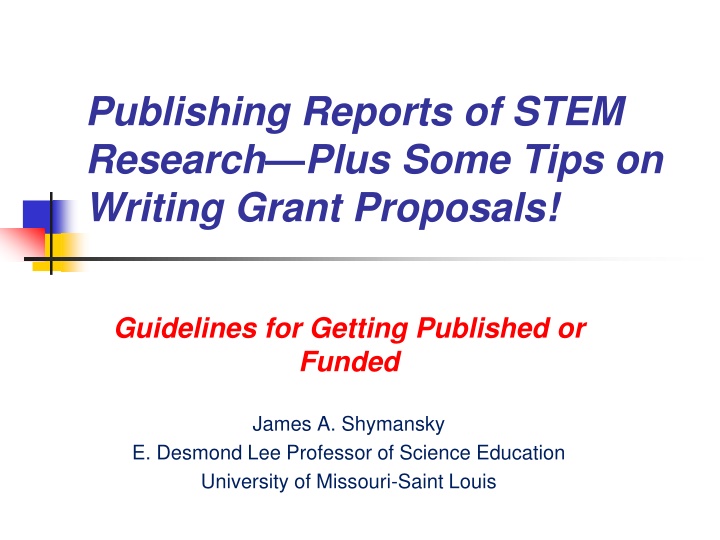
Effective Strategies for Publishing STEM Research and Writing Grant Proposals
Learn valuable insights on publishing reports of STEM research, along with practical tips for crafting successful grant proposals. Explore guidelines for audience targeting, problem identification, knowledge generation, and persuasive case-making to boost your chances of publication and funding.
Download Presentation

Please find below an Image/Link to download the presentation.
The content on the website is provided AS IS for your information and personal use only. It may not be sold, licensed, or shared on other websites without obtaining consent from the author. If you encounter any issues during the download, it is possible that the publisher has removed the file from their server.
You are allowed to download the files provided on this website for personal or commercial use, subject to the condition that they are used lawfully. All files are the property of their respective owners.
The content on the website is provided AS IS for your information and personal use only. It may not be sold, licensed, or shared on other websites without obtaining consent from the author.
E N D
Presentation Transcript
Publishing Reports of STEM Research Plus Some Tips on Writing Grant Proposals! Guidelines for Getting Published or Funded James A. Shymansky E. Desmond Lee Professor of Science Education University of Missouri-Saint Louis
Before writing or proposing: Who is the audience? Is the question important? Will new knowledge emerge? Can a case be made? 2
Critical Components of a Manuscript Introduction Problem Space Literature Review Theory & Place Design Warrants & Backing Results Evidence from Data Discussion Claims, Counterclaims & Rebuttals 3 3
Title Be concise but understandable Include as many key terms as possible Avoid acronyms and unknown terms 4
Abstract & Keywords Keywords 5 to 10 words or short phrases Alphabetical order Abstract The last thing to write Interesting and readable Avoid references Concise (120 200 words) APA provides items that should be described in abstracts for 5 types of articles Abstract (cont.) Clear connections to: Problem space Research questions Theoretical frameworks Procedures Results Potential implications Title 5
Introduction Be brief and be interesting 1 or 2 paragraphs, not more than 1 page Set the context, problem space and need for the study (rationale) Clearly state the research questions, focus, purpose, or goal Provide brief notes on research methods that will be used 6
Background Explain study s place or fit Provide theoretical framework Cite only recent, relevant literature 7
Research design Provide overview of research approach Describe the treatments What were the participants to do? What was done to the participants? Describe the subjects or informants This description may serve as basis for readers generalizations. 8
Research design (continued) Describe data sources and collection techniques Reliability and validity Equipment demands Provide interpretive frameworks or data analysis procedures Scoring rubrics Choice of statistical analyses Coding procedures and verification 9
(Quantitative) Results Provide essential tables and graphs Identify significant patterns in data Point out critical anomalies in data Present post-hoc analyses as needed Use appendices when available 10
(Qualitative) Results Use boldface type to set off assertions Use italics to set off evidence, such as informant quotes and text excerpts Use appendices or publisher websites for lengthy data records 11
Discussion and Implications State claims with evidence; do not just repeat results Connect claims to initial need, theory and literature Rebut counterclaims/alternative explanations Share implications and questions for future research 12
Appendices, Notes, and Acknowledgements Not necessarily part of every paper or article Some journals allow only online access to appendices Funding support and assistance with data collection, writing, reviewing or revising may be acknowledged as a professional courtesy 13
Manuscript rejected?? Is the manuscript salvageable? Can reported data be re-analyzed? Are there other data to consider? Can/should other data be collected? Could a new co-author help? Co-authorship issues? Should another journal be considered? Persevere; don t give up!! 14
Post-script: Writing a grant, not a paper A grant proposal argues a case for something yet to be done, not for something that has been done. There are no data to report or results to defend, but an argument must still be made!! 15
The proposal argument** Need for project** Project design/plan** Staff expertise** Cost** 16
Proposal not funded: To revise and resubmit or not? Need for project? Most likely cause for rejection difficult to fix hope for change of reviewer group. Design/plan? Many possible reasons but usually feasible to fix. Staff expertise? Personal challenge think about changing the team! 17
A Final Recommendation (based on many years of rejected papers and proposals): Persevere! In almost all cases you can find a place to publish your research, if not in the first journal you chose, then in an alternative one. There are fewer places to submit grant proposals, but the advice is the same Persevere! 18

